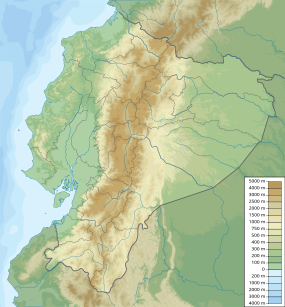Las Vegas culture
| Location | Ecuador |
|---|---|
| Coordinates | 2°14′S 80°52′W / 2.233°S 80.867°WCoordinates: 2°14′S 80°52′W / 2.233°S 80.867°W |
| Type | Multiple ruins of settlements, some dating to 10,000 years ago. |
| History | |
| Founded | c. 8000 BCE |
| Abandoned | c. 4600 BCE |
| Cultures | Las Vegas culture |
The Las Vegas culture is the name given to a large number of Holocene settlements which flourished between 8000 BCE and 4600 BCE.(10,000 to 6,600 BP) near the coast of present-day Ecuador. The name comes from the location of the most prominent settlement, Site No. 80, near the Las Vegas River and now within the city of Santa Elena. The Las Vegas culture represents "an early, sedentary adjustment to an ecologically complex coastal environment."
The Las Vegas culture is important because it was one of the earliest cultures in South America to practice agriculture.
The Las Vegas culture was located on the Santa Elena Peninsula of Ecuador. The Santa Elena peninsula is the northernmost extension of the coastal desert that stretches for some 3,000 kilometres (1,900 mi) along the Pacific coast of South America. The city of Santa Elena receives about 250 millimetres (9.8 in) of precipitation annually nearly all of it from January to March. Under the influence of the cool waters of the Humboldt Current, temperatures are mild, averaging 23 °C (73 °F) with only a few degrees in seasonal variation. The natural vegetation near the coast is xeric featuring cacti and other desert plants. Inland, precipitation generally increases and the vegetation becomes more varied and lush, changing from desert to seasonally dry forest..
Ten thousand years ago sea level on the Santa Elena peninsula was 30 metres (98 ft) lower than at present. Thus, the known settlements of the Las Vegas period were further inland then than they are now and some ancient settlements may have been covered by the rising sea. The dry climate and xeric vegetation seem to have persisted throughout the 10,000 year period.
Thirty-two Las Vegas sites have been identified on the Santa Elena peninsula, scattered over an area about 25 kilometres (16 mi) east-west and 12 kilometres (7.5 mi) north-south, most along the Rio Grande and its tributaries, including the Las Vegas River. Additional similar sites of human habitation probably remain to be discovered near and along several hundred miles of Ecuadorian coast
Evidence of a human presence of the Santa Elena peninsula has been radiocarbon dated back to 8800 BCE, but with the onset of the Las Vegas period about 8000 BC, the evidence becomes much more extensive. Archaeologists have divided the Las Vegas culture into two periods: early Las Vegas from 8000 to 6000 BCE, and late Las Vegas from 6000 BCE to 4600 BCE. The dividing line between the two periods is a lacuna in the archaeological record at one representative site. The Las Vegas culture was pre-ceramic, meaning that the people did not utilize pottery.
...
Wikipedia

